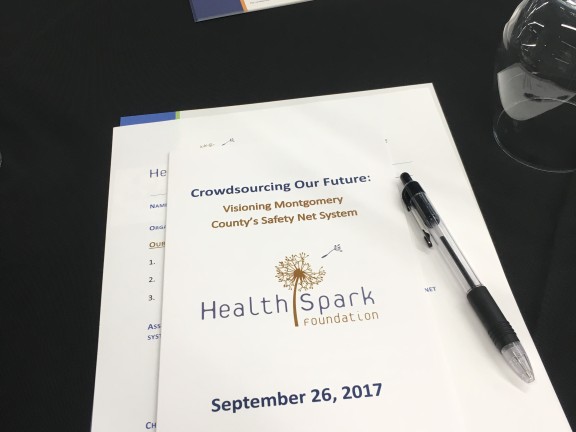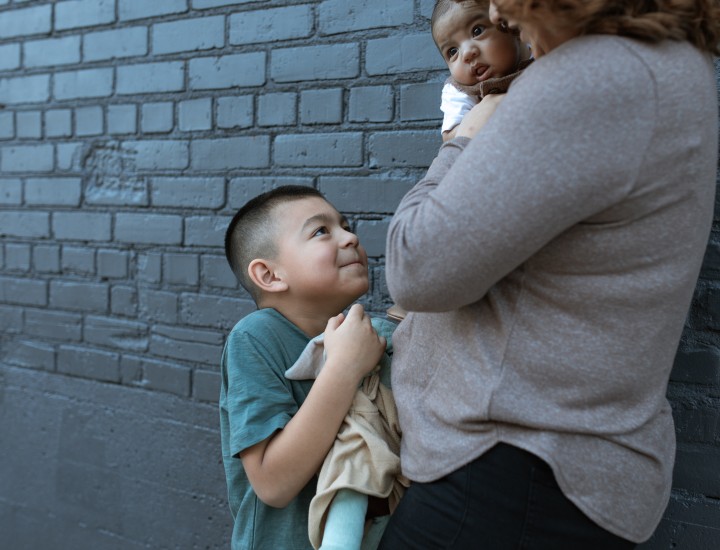HealthSpark Hosts Crowdsourcing Events on Safety Net Resiliency

In the fall of 2017, HealthSpark Foundation hosted two events with nonprofit, county government and philanthropic representatives to discuss Montgomery County's health and human services safety net.
Approximately 100 organizations attended one or both meetings, which were facilitated by national communications consultants Spitfire Strategies.
Purpose of Events
The foundation hosted these events to inform its plans for a new initiative to improve the resiliency of the county's safety net system. By “crowdsourcing” what it means to have a resilient safety net, a vision was developed from the September meeting, and a deeper dive in October helped refine that vision to life and establish areas of work to pursue.
What We Heard – September Meeting
Attendees saw the safety net as an important, essential component to protect those in greatest need, but enumerated several of its challenges. They would like to see a safety net that is responsive to community need; many described a system as a “trampoline,” helping people in crisis to bounce back from their current challenges.
Attendees also identified possible areas of collaborative work that should be explored to strengthen the safety net system: public/private coordination, culturally appropriate services, data sharing/systems integration, coordination of services/”no wrong door,” transportation and advocacy.
What We Heard – Oct Meeting
Based on the themes that arose at the September meeting, the following draft vision for the county's safety net was developed and presented:
We envision a resilient and financially sustainable safety net that allows anyone in Montgomery County to access high quality, coordinated, equitable and culturally appropriate services no matter who they are, what they need or where they live.
Attendees provided excellent feedback on the draft vision identifying several points of tension: emergency vs. supportive services, crisis vs. preventive interventions and client-driven vs. organization-driven approaches. Additional possible areas of collaborative work were added, including financial sustainability and leadership development.
Three rounds of voting ensued to identify where attendees felt there was the most urgency for the system, which challenges are most feasible to tackle at both the system and organizational levels and what was of most interest to their organization.
Four opportunities attracted substantial support:
- Public/private collaboration/coordination
- “No wrong door” entry to the safety net
- Data sharing/systems integration
- System advocacy
Attendees divided themselves among these four breakout groups to identify who was missing from the conversation, what information or additional questions need to be answered to nurture transformational work at the systems level, and to identify specific challenges/obstacles and opportunities that could help “jump-start” this work.
What We Will Do With This Information
Over the course of the past eighteen months, the foundation has been working to develop a new initiative designed to improve the resiliency of the county's health and human service safety net system and the organizations that contribute to and support the system. It has distributed surveys, hired a consultant to conduct both focus groups and in-depth key informant interviews with the provider community and have hosted these two events to further “crowdsource” ideas and feedback. Along with its planning consultants Equal Measure, the foundation is incorporating we heard from these various channels to finalize the design for the new initiative.
Next Steps
The foundation will soon launch this initiative. Details will be published on its website.
The foundation views its role as a catalyst for change and a partner to each organization sharing our vision and goals to enhance the resiliency of the health and human service system in Montgomery County. We intend to maintain our dialogue with the community through an inclusive and respectful exchange of ideas to invest in promising ideas we all believe will have a positive and desired impact on the system serving at-risk and vulnerable individuals and families.


